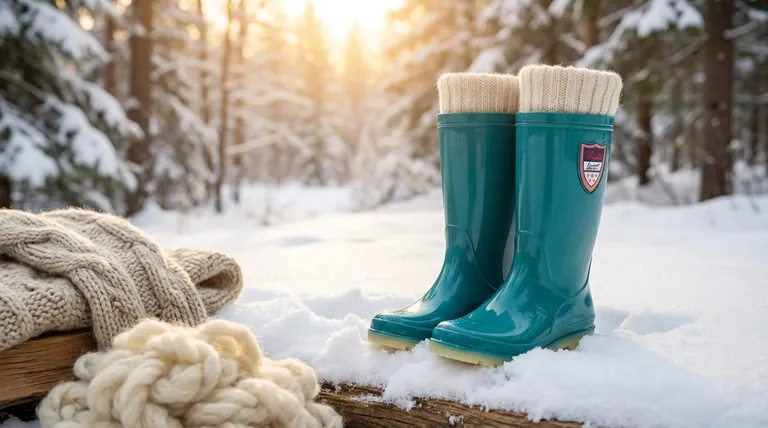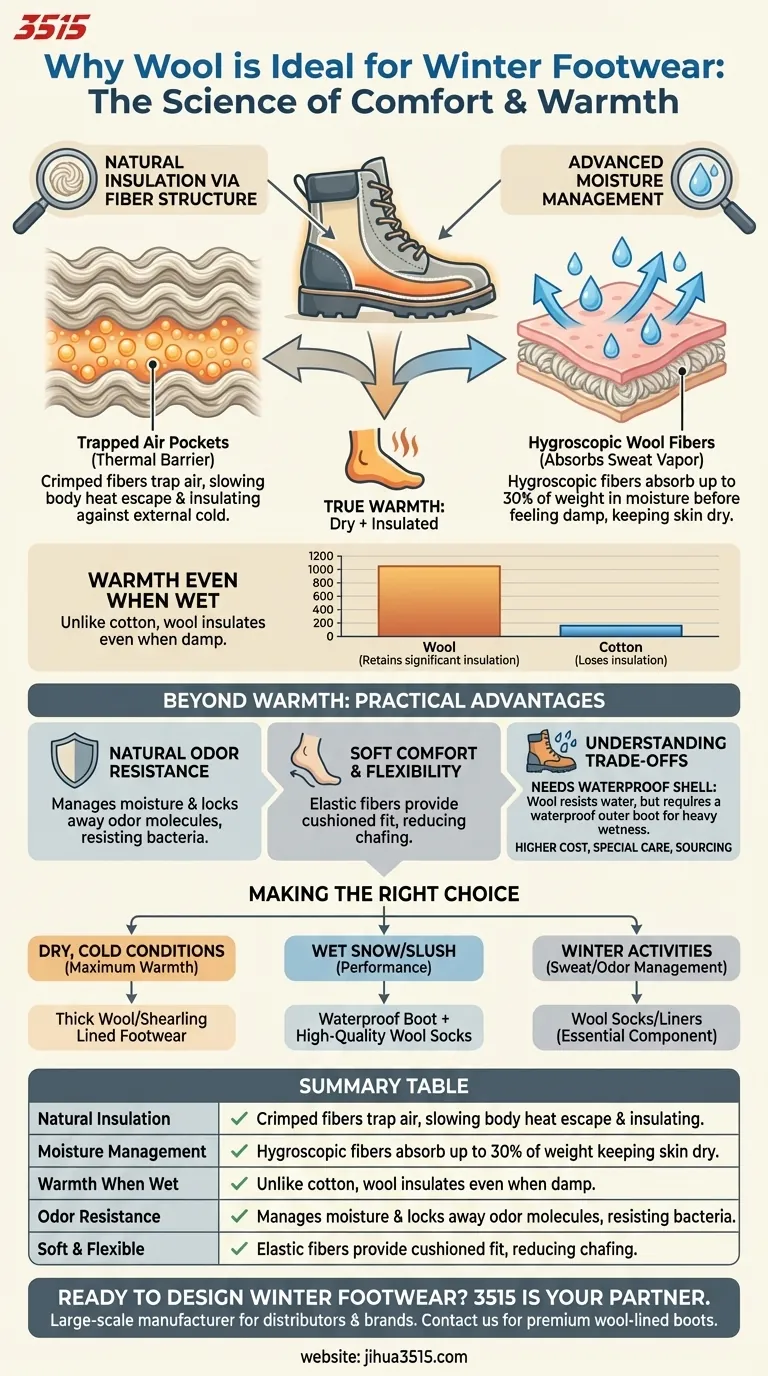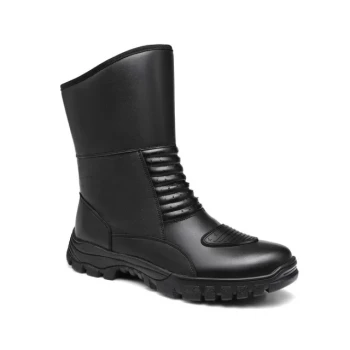At its core, wool is uniquely suited for winter footwear because it provides exceptional insulation while actively managing moisture. Unlike many materials that only trap heat, wool's natural fibers pull sweat away from the skin, keeping your feet dry—and therefore, truly warm—in cold conditions.
The real advantage of wool isn't just its ability to insulate. It's the combination of trapping heat in its millions of air pockets while simultaneously wicking moisture away, preventing the damp, chilling effect that makes feet feel cold.

The Science of Wool: A Two-Part System for Warmth
To understand wool's effectiveness, you have to look beyond simple insulation. It operates on two critical principles that work together to create a comfortable microclimate for your feet.
Natural Insulation via Fiber Structure
The individual fibers of wool are naturally crimped, creating millions of tiny air pockets within the fabric. This trapped air acts as a powerful thermal barrier, slowing the escape of your body heat and insulating you from the external cold.
Advanced Moisture Management
This is what truly sets wool apart. The material is hygroscopic, meaning it can absorb a significant amount of moisture vapor (sweat) before it condenses into liquid.
Wool can hold up to 30% of its own weight in moisture without feeling damp to the touch. This process keeps your skin dry, which is the most critical factor in preventing heat loss and discomfort in winter.
Warmth Even When Wet
In situations where wool does become saturated, it still retains a large portion of its insulating properties. This is a stark contrast to materials like cotton, which loses nearly all its insulating ability when wet and rapidly pulls heat away from the body.
Beyond Warmth: The Practical Advantages of Wool
Wool's benefits extend beyond its thermal and moisture-wicking capabilities, making it a highly practical choice for everyday winter use.
Natural Odor Resistance
Because wool manages moisture so effectively, it creates an environment less hospitable to the growth of odor-causing bacteria. The complex structure of the fibers also helps to lock away odor molecules.
Soft Comfort and Flexibility
Wool fibers are naturally elastic and flexible, providing a soft, cushioned feel that conforms to your foot. This reduces the risk of chafing and blisters, which can be a problem with stiffer, less forgiving synthetic materials often found in winter boots.
Understanding the Trade-offs and Considerations
While wool is an exceptional material, it's essential to be aware of its limitations to make an informed decision. It is an excellent insulator, but it is not a complete winter solution on its own.
The Need for a Waterproof Shell
Wool is water-resistant, not waterproof. For use in heavy snow, slush, or rain, wool linings and socks must be paired with footwear that has a truly waterproof outer shell, such as a quality snow boot or wellie. Wool manages internal moisture (sweat), while the outer boot manages external moisture (snow and water).
Higher Cost
High-quality wool, particularly merino wool or shearling, typically comes at a higher price point than common synthetic insulators like polyester or fleece.
Special Care Requirements
Wool is a natural fiber that can shrink or become damaged if not cared for properly. Most wool-lined footwear or wool garments require specific washing and air-drying procedures.
Ethical and Sourcing Concerns
As an animal product, wool is not a vegan material. Consumers concerned with animal welfare should look for brands that adhere to responsible and humane sourcing standards.
Making the Right Choice for Your Needs
Selecting the right footwear means matching the material's strengths to your specific environment and activity level.
- If your primary focus is maximum warmth in dry, cold conditions: Footwear with a thick, integrated wool or shearling lining is an ideal choice for its unparalleled insulation and comfort.
- If your primary focus is performance in wet snow or slush: Prioritize a boot with a guaranteed waterproof exterior and use high-quality wool socks to provide the essential insulation and moisture-wicking from within.
- If your primary focus is managing foot sweat and odor during winter activities: Wool is superior to almost any synthetic alternative, making wool socks or liners a non-negotiable component of your footwear system.
Ultimately, choosing the right winter footwear is about understanding how different materials work together as a complete system.
Summary Table:
| Key Property | How It Benefits Winter Footwear |
|---|---|
| Natural Insulation | Crimped fibers trap air, creating a powerful thermal barrier against the cold. |
| Moisture Management | Hygroscopic fibers absorb sweat, keeping feet dry to prevent heat loss. |
| Warmth When Wet | Retains insulating properties even when damp, unlike cotton. |
| Odor Resistance | Creates an inhospitable environment for odor-causing bacteria. |
| Soft & Flexible | Elastic fibers provide cushioned comfort and reduce chafing. |
Ready to design or source winter footwear that leverages wool's natural advantages?
As a large-scale manufacturer, 3515 produces a comprehensive range of footwear for distributors, brand owners, and bulk clients. Our production capabilities encompass all types of shoes and boots, including high-performance winter styles with premium wool linings and insulation.
We can help you create products that offer the perfect balance of warmth, comfort, and moisture management your customers need. Contact our experts today to discuss your next winter footwear project.
Visual Guide

Related Products
- Factory Direct Wholesale Rain Boots Durable Waterproof & Fully Customizable
- Wholesale Lightweight Tactical Boots Custom Manufacturer for Desert & Combat Use
- Factory-Direct Wholesale Canvas Boots with High-Traction Rubber Soles
- Wholesale Tactical Boots High-Traction & Reflective for Bulk & Brand Orders
- Wholesale Waterproof Tactical Boots Custom Suede & High-Traction Soles
People Also Ask
- What are the limitations of rain boots in certain climates? Find the Right Footwear for Your Weather
- What are the key characteristics of rain boots? Essential Features for Total Dryness
- What are rain boots made of? Discover the best materials for ultimate waterproof protection.
- What variety of rubber boots is available? From Rain to Safety and Medical Solutions
- What are the main materials used in the production of rain boots? A Guide to Durability & Comfort



















